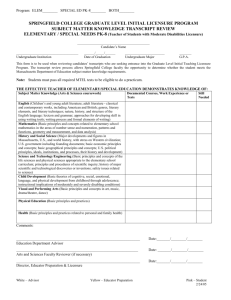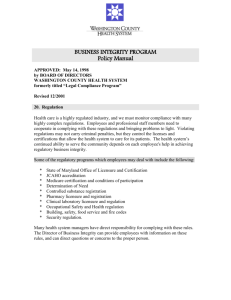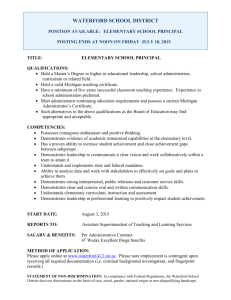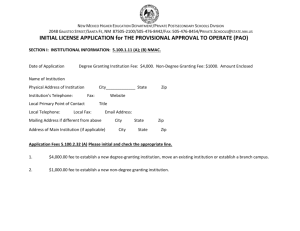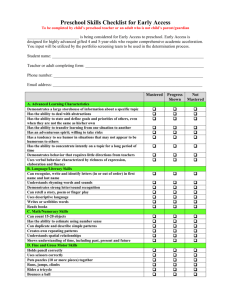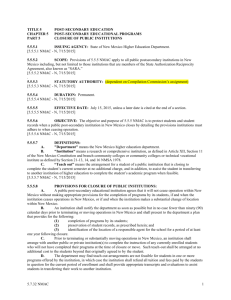6.61.2 NMAC - New Mexico State Department of Education
advertisement
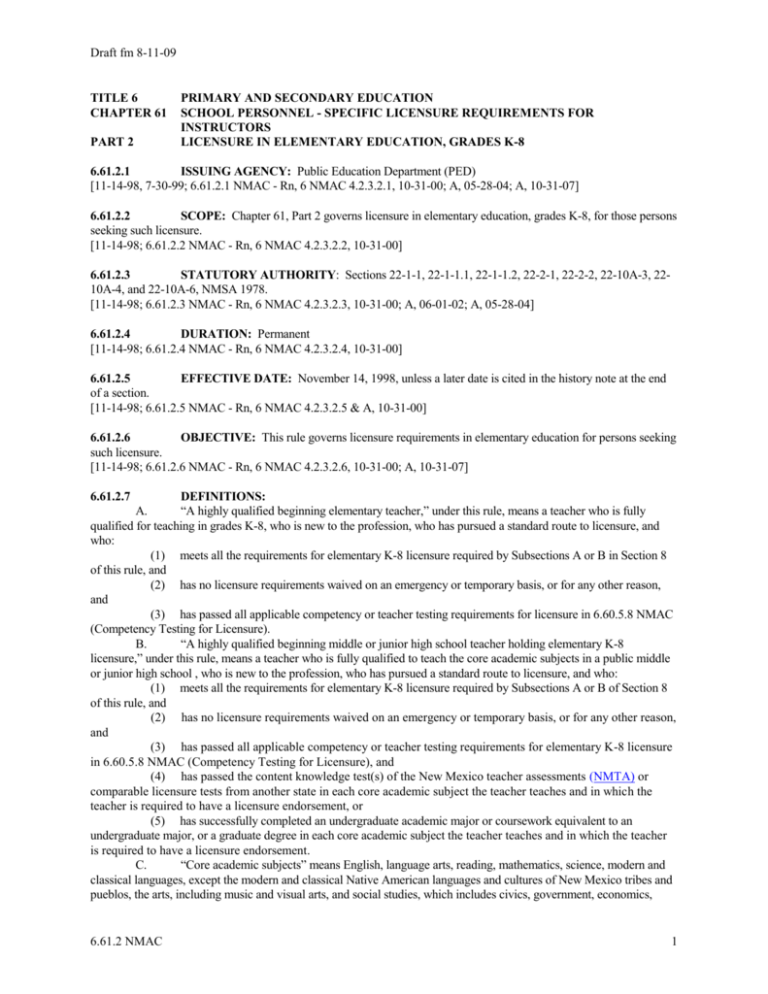
Draft fm 8-11-09 TITLE 6 CHAPTER 61 PART 2 PRIMARY AND SECONDARY EDUCATION SCHOOL PERSONNEL - SPECIFIC LICENSURE REQUIREMENTS FOR INSTRUCTORS LICENSURE IN ELEMENTARY EDUCATION, GRADES K-8 6.61.2.1 ISSUING AGENCY: Public Education Department (PED) [11-14-98, 7-30-99; 6.61.2.1 NMAC - Rn, 6 NMAC 4.2.3.2.1, 10-31-00; A, 05-28-04; A, 10-31-07] 6.61.2.2 SCOPE: Chapter 61, Part 2 governs licensure in elementary education, grades K-8, for those persons seeking such licensure. [11-14-98; 6.61.2.2 NMAC - Rn, 6 NMAC 4.2.3.2.2, 10-31-00] 6.61.2.3 STATUTORY AUTHORITY: Sections 22-1-1, 22-1-1.1, 22-1-1.2, 22-2-1, 22-2-2, 22-10A-3, 2210A-4, and 22-10A-6, NMSA 1978. [11-14-98; 6.61.2.3 NMAC - Rn, 6 NMAC 4.2.3.2.3, 10-31-00; A, 06-01-02; A, 05-28-04] 6.61.2.4 DURATION: Permanent [11-14-98; 6.61.2.4 NMAC - Rn, 6 NMAC 4.2.3.2.4, 10-31-00] 6.61.2.5 EFFECTIVE DATE: November 14, 1998, unless a later date is cited in the history note at the end of a section. [11-14-98; 6.61.2.5 NMAC - Rn, 6 NMAC 4.2.3.2.5 & A, 10-31-00] 6.61.2.6 OBJECTIVE: This rule governs licensure requirements in elementary education for persons seeking such licensure. [11-14-98; 6.61.2.6 NMAC - Rn, 6 NMAC 4.2.3.2.6, 10-31-00; A, 10-31-07] 6.61.2.7 DEFINITIONS: A. “A highly qualified beginning elementary teacher,” under this rule, means a teacher who is fully qualified for teaching in grades K-8, who is new to the profession, who has pursued a standard route to licensure, and who: (1) meets all the requirements for elementary K-8 licensure required by Subsections A or B in Section 8 of this rule, and (2) has no licensure requirements waived on an emergency or temporary basis, or for any other reason, and (3) has passed all applicable competency or teacher testing requirements for licensure in 6.60.5.8 NMAC (Competency Testing for Licensure). B. “A highly qualified beginning middle or junior high school teacher holding elementary K-8 licensure,” under this rule, means a teacher who is fully qualified to teach the core academic subjects in a public middle or junior high school , who is new to the profession, who has pursued a standard route to licensure, and who: (1) meets all the requirements for elementary K-8 licensure required by Subsections A or B of Section 8 of this rule, and (2) has no licensure requirements waived on an emergency or temporary basis, or for any other reason, and (3) has passed all applicable competency or teacher testing requirements for elementary K-8 licensure in 6.60.5.8 NMAC (Competency Testing for Licensure), and (4) has passed the content knowledge test(s) of the New Mexico teacher assessments (NMTA) or comparable licensure tests from another state in each core academic subject the teacher teaches and in which the teacher is required to have a licensure endorsement, or (5) has successfully completed an undergraduate academic major or coursework equivalent to an undergraduate major, or a graduate degree in each core academic subject the teacher teaches and in which the teacher is required to have a licensure endorsement. C. “Core academic subjects” means English, language arts, reading, mathematics, science, modern and classical languages, except the modern and classical Native American languages and cultures of New Mexico tribes and pueblos, the arts, including music and visual arts, and social studies, which includes civics, government, economics, 6.61.2 NMAC 1 Draft fm 8-11-09 history, and geography. D. “Undergraduate academic major” under this rule, means twenty-four (24) to thirty-six (36) semester hours in a core academic subject area. [6.61.2.7 NMAC - N, 06-30-03; A, 05-28-04; A, XX-XX-09] 6.61.2.8 REQUIREMENTS: A. Persons seeking licensure in elementary education pursuant to the provisions of this rule shall meet the requirements enumerated in Subsection A or Subsection B of this section. (1) bachelor's degree from a regionally accredited college or university and including, for those students first entering a college or university beginning in the fall of 1986, the following: (a) twelve (12) semester hours in English; (b) twelve (12) semester hours in history including American history and western civilization; (c) six (6) semester hours in mathematics; for candidates who entered a college or university prior to the fall semester of 2009 and nine (9) semester hours in mathematics for candidates who entered a college or university in or after the fall semester of 2009; (d) six (6) semester hours in government, economics or sociology; (e) twelve (12) semester hours in science, including biology, chemistry, physics, geology, zoology, or botany; (f) six (6) semester hours in fine arts; and (2) credits from a regionally accredited college or university which include thirty to thirty-six (30-36) semester hours of professional education in an elementary education program approved by the PED, including completion of the PED's approved functional areas and related competencies in professional education; and (3) a mandatory student teaching component; and (4) twenty-four to thirty-six (24-36) semester hours in one teaching field such as mathematics, science(s), language arts, reading, and social studies (or other content related areas). Individuals must also complete the PED's approved functional areas and related competencies in the teaching field; and (5) in addition to the requirements specified in Subsection A, Paragraphs (1), (3), (4), (6) and (7) of 6.61.2.8 NMAC, six (6) hours in the teaching of reading for those who have first entered any college or university on or after August 1, 2001 regardless of when they graduate or earn their degree; and (6) pass all required portions of the [New Mexico teacher assessments] NMTA or any successor teacher examination adopted by the [department] PED; and (7) if teaching in an elementary school, satisfy the requirements of a highly qualified beginning elementary teacher, and (8) if teaching the core academic subjects in a middle or junior high school, satisfy the requirements of a highly qualified beginning middle or junior high school teacher holding elementary K-8 licensure, or B. Possess a valid certificate issued by the national board for professional teaching standards for the appropriate grade level and type. [11-14-98; 6.61.2.8 NMAC - Rn, 6 NMAC 4.2.3.2.8 & A, 10-31-00; A, 06-01-02; A, 06-30-03; A, 05-28-04; A, 10-3107; A, XX-XX-09] 6.61.2.9 [Reserved] [11-14-98; 6.61.2.9 NMAC - Rn, 6 NMAC 4.2.3.2.9, 10-31-00; Repealed, 06-30-03] 6.61.2.10 A. REFERENCED MATERIAL: Competencies for entry level elementary teachers Professionalism (1) The teacher reflects on, analyzes, and evaluates the effect of his or her choices and actions on others, including students, parents, and other professionals in the learning community, and will be able to use this knowledge to improve the learning process. (2) The teacher is aware of the need to actively seek out opportunities to grow professionally, including participation in professional organizations and professional development such as conferences, workshops, classes and research, and use this information to improve professional practices and to become a life-long learner. (3) The teacher participates in an on-going process of researching current educational issues and practices, applying them in the classroom, and monitoring their effects. (4) The teacher understands their role in the educational decision-making process as an advocate for children, school, district, community, and self. 6.61.2 NMAC 2 Draft fm 8-11-09 (5) The teacher is aware of and adheres to the educator code of ethics and professional standards. (6) The teacher demonstrates an awareness of relevant legal requirements of teachers and schools. (7) The teacher demonstrates an awareness of the structure of local, state, and federal agencies and educational systems. (8) The teacher critically reviews, selects, and adapts materials, resources, and technologies and analyzes them for: (a) age appropriateness; (b) developmental level; (c) cultural and linguistic background; (d) exceptionalities; (e) biases and stereotypes; (f) content appropriateness in regard to curriculum; (g) reading level; (h) relevance to students. B. Instructional planning and implementation: (1) The teacher understands learning theory, subject matter, and curriculum development and uses this knowledge in planning instruction to meet curriculum goals. (2) The teacher takes into account the physical, social, emotional, cognitive, and linguistic development of students when planning instruction. (3) The teacher plans learning opportunities, recognizing the various learning styles of individuals/groups, according to the nature of the content being taught. (4) The teacher creates short- and long-term plans that are linked to student needs, performance, and learning styles. (5) The teacher becomes familiar with students’ families, cultures and communities, and plans related learning activities. (6) The teacher plans lessons that provide for the success of students with exceptionalities, including learning disabilities, visual and perceptual difficulties, and physical or mental challenges. (7) The teacher integrates a variety of technologies into planned activities including software, applications, and other learning tools. (8) The teacher plans activities to promote higher order thinking skills, creativity, and independent thinking. (9) The teacher plans and uses assessment strategies and instruments appropriate to the learning outcomes being evaluated. (10) The teacher evaluates lesson plans by observing classroom interactions, questioning, and analyzing student work. (11) The teacher develops sequential lessons that include knowledge of the discipline, student diversity, the local community, and the district/state curriculum goals. C. Classroom management: (1) The teacher knows effective models of classroom management and has the opportunity to observe these in classroom situations. (2) The teacher develops and implements a classroom management plan. (3) The teacher responds to children as individuals. (4) The teacher provides a safe classroom environment where individual differences are respected. (5) The teacher arranges the classroom environment for optimal learning and students’ success. (6) The teacher seeks student understanding and input for classroom procedures, rules, and consequences. (7) The teacher models and encourages positive social interaction. (8) The teacher collaborates with specialists, support personnel, parents, and administrators in an interdisciplinary manner for the success of the individual student. (9) The teacher uses data collection techniques to document classroom management. (10) The teacher manages time and materials effectively to minimize distractions and disruptions. (11) The teacher develops activities and transitions that guide students to be focused. D. Assessment: (1) The teacher understands and uses formal and informal assessment strategies to evaluate and ensure the continuous intellectual, social, physical, and aesthetic development of the learner. 6.61.2 NMAC 3 Draft fm 8-11-09 (2) (3) (4) (5) The teacher develops valid evaluation tools to measure student outcomes. The teacher selects materials and means for measuring progress. The teacher assesses students’ current knowledge in order to plan instruction. The teacher uses assessment of student learning to improve their own teaching and to revise curriculum. (6) The teacher interprets and uses results of standardized instruments, including and understanding of percentiles, means, stanines, grade equivalence, and item analysis. (7) The teacher uses observation skills for informal assessment. (8) The teacher is able to use effective questioning techniques to better assess the student’s knowledge. (9) The teacher recognizes developmental levels of student knowledge and skills including typical and atypical patterns. (10) The teacher recognizes unethical, illegal, and otherwise inappropriate assessment methods and uses of assessment information. (11) The teacher demonstrates familiarity with a variety of assessment tools, including but not limited to portfolios, performance-based assessment, and student writing. (12) The teacher uses student responses, explanations, and demonstrations, to analyze misunderstandings that led to errors (error analysis). (13) The teacher is aware that there may be a variety of methods, strategies, or procedures that will give a correct answer. (14) The teacher is skilled in communicating assessment results to students, parents, lay audiences, and other educators. E. Technology: (1) Basic computer and technology operations and concepts - the teacher uses computer systems to: run software, access, generate, and manipulate data; and publish results. The teacher evaluates performance of hardware and software components of computer systems and applies basic troubleshooting strategies as needed. (a) operates a multimedia computer system with related peripheral devises to successfully install and use a variety of software packages; (b) uses terminology related to technology appropriate to the teaching field in written and oral communication; (c) describes and implement basic troubleshooting techniques for multimedia computer systems with related peripheral devices; (d) uses imaging devices; (e) demonstrates knowledge of uses of computers and technology in business, industry, and society; (f) operates a variety of audio-visual devices. (2) Personal and professional use of technology - the teacher will apply tools for enhancing their own professional growth and productivity. The teacher will use technology in communicating, collaborating, conducting research, and solving problems. In addition, the teacher will plan and participate in activities that encourage lifelong learning and will promote equitable, ethical, and legal use of computer and technology resources. (a) uses productivity tools for word processing, database management, and spreadsheet applications when developmentally appropriate; (b) applies productivity tools for creating a multimedia presentation; (c) uses computer-based technologies including telecommunications to access information and enhance personal and professional productivity; (d) uses computers to support problem solving, data collection, information management, communications, presentations, and decision making; (e) demonstrates awareness of resources for adaptive assistive devices and software for students with special needs; (f) demonstrates awareness of resources for culturally and linguistically diverse students; (g) demonstrates knowledge of equity, ethics, legal, and human issues concerning use of computers and technology; (h) demonstrates awareness of computer and related technology resources for facilitating lifelong learning and emerging roles of the learner and the educator; (i) demonstrates awareness of broadcast instruction, audio/video conferencing, and other 6.61.2 NMAC 4 Draft fm 8-11-09 distant learning applications. (3) Application of technology to support teaching and learning - the teacher applies computers and related technologies to support teaching and learning in the grade level and subject areas. The teacher will integrate a variety of software, applications, and learning tools in the teaching and learning process. Lessons developed must reflect effective grouping and assessment strategies for diverse populations. (a) explores, evaluates, and uses technology resources including applications, tools, educational software, and assorted documentation; (b) describes best practice and appropriate assessment as related to the use of technology resources in the curriculum; (c) designs, implements, and assesses learning activities that integrate technology for a variety of grouping strategies for diverse populations; (d) designs learning activities that foster equitable, ethical, and legal use of technology by students; (e) practices responsible, ethical, and legal use of technology, information, and software resources. F. Diversity: (1) The teacher understands how students differ in their approaches to learning and creates instructional opportunities that are adapted to diverse learners. (2) The teacher organizes and manages varied learning groups as appropriate in each of the disciplines as appropriate to the needs and/or interests of students and the goals of the lesson. (3) The teacher is aware of and can apply current research findings regarding individual differences such as linguistic backgrounds, developmental levels, exceptionalities, and gender. (4) The teacher identifies stereotypes in curriculum materials and adapts instruction appropriately. (5) The teacher helps students develop critical perspectives on biased materials. (6) The teacher identifies and develops appropriate responses to differences among language learners. (7) The teacher demonstrates sensitivity to New Mexico’s unique linguistic and cultural diversity. G. Family and community: (1) The teacher is aware of the culture, history, and values of the community in which he or she teaches. (2) The teacher understands, respects, and values the central role that community and family play in the learning process of a child and will be able to utilize these experiences to enhance learning. (3) The teacher understands that there must be a reciprocal relationship between the school and the community. (4) The teacher values and utilizes the knowledge that all community members have something to contribute to the classroom to assist in the educational process. (5) The teacher recognizes that families and community can be used as teaching resources to enhance learning and children’s self value. (6) The teacher communicates to parents and community members student progress, important events, and school activities. (7) The teacher understands the importance of inviting parents and community members to participate in classroom and school curriculum development and the decision making process. (8) The teacher conveys and demonstrates to students the importance of being an active part of the community. H. Inclusion: (1) The teacher understands special education rules. (2) The teacher understands the differing levels of disabilities. (3) The teacher understands the development and use of individualized education plans (IEPs). (4) The teacher understands their responsibilities in implementing objectives set in an IEP. (5) The teacher develops lessons according to IEPs. (6) The teacher monitors achievement and growth as set by an IEP and recommends changes when necessary. (7) The teacher collaborates with special education teachers for individualized program implementation. (8) The teacher adjusts lessons and strategies for students with exceptionalities with regard to academic levels, physical environment, and emotional needs. 6.61.2 NMAC 5 Draft fm 8-11-09 (9) The teacher understands the social, emotional, physical, and academic needs of students with exceptionalities. (10) The teacher assists students to understand social responsibilities. (11) The teacher assists students with exceptionalities to have positive experiences in the regular classroom. I. Development of student: (1) The teacher understands various theories of cognitive, social, aesthetic, emotional and physical development. (2) The teacher understands how children learn and develop, and provides learning opportunities that support their cognitive, social, aesthetic, emotional, and physical development. (3) The teacher develops curriculum and implements instructional strategies appropriate to the developmental level of each child, leading to continuous progress. J. Knowledge of content: (1) Mathematics (a) The teacher understands mathematical concepts including but not limited to: (i) the arithmetic of real numbers and their subsets of rational numbers, integers, and whole numbers; (ii) three dimensional geometry based on the concept of distance, and two dimensional geometry as a method of drawing plans and representing three dimensional objects; (iii) elements of algebra including elementary functions; (iv) measurement of length, angles, time, weights, and temperature; and (v) handling money problems such as cost and unit price. (b) The teacher demonstrates skill including but not limited to: (i) mental computations and proper use of four operation and non-programmable scientific calculators in the context of problem solving; (ii) constructions of solids, measurements of their volumes and surface areas, drawing their projections, and making plans for their construction; (iii) defining relevant variables and writing formulas describing their relationships in problem-solving activities; and (iv) using measurement tools and appropriate techniques for recording data and displaying results. (c) The teacher demonstrates adequate communication skills to be able to discuss mathematical ideas verbally and in writing. (d) The teacher knows a variety of teaching techniques and chooses ones appropriate to the topic of study and the level and needs of students. (e) The teacher constructs situations in which students learn to use a variety of mathematical skills and concepts, including problem solving, reasoning, and logic. (f) The teacher provides opportunities for students to learn how to use tools, technology, and manipulatives in problem solving. (g) The teacher uses measurements and other data gathered by students as a basis for classroom activities. (h) The teacher provides a classroom environment in which students develop skills in communicating, discussing, and displaying mathematical ideas. (i) The teacher provides enough open-ended problems and activities to allow students to expand creatively on the material learned in classrooms. (2) Reading and language arts: (a) Foundations: the teacher understands the foundations of reading and language arts development, including but not limited to: (i) research on reading; (ii) how children learn to speak, read, write, and listen; (iii) cultural, linguistic, environmental, and physiological factors in reading and language arts development; (iv) children’s developmental processes; (v) characteristics of proficient and non-proficient readers; (vi) relationship between oral and written language; 6.61.2 NMAC 6 Draft fm 8-11-09 (vii) language structure including graphophonics, semantics, syntax, and pragmatics systems. (b) Assessment: (i) The teacher understands the use of classroom reading assessment to diagnose students’ instructional needs and modify instruction appropriately. (ii) The teacher links assessment and instruction to New Mexico language arts content standards, benchmarks and performance standards. (c) Methods of instruction: the teacher differentiates methods of instruction based on needs of students and designs instruction based on the following reading and language arts components: (i) oral language development; (ii) phonemic awareness and phoneme manipulations, such as blending, segmentation, and substitution; (iii) phonics instruction, including a variety of strategies such as systematic, explicit instruction and the use of phonics in reading and writing; (iv) vocabulary development, including both explicit instruction and indirect vocabulary development through authentic literature and students’ experiences; (v) comprehension strategies, including: instruction on predicting, re-reading, questioning, sequencing, summarizing, retelling, reading for pleasure and analytical and critical reading; activities to develop fluency, the ability to read text accurately and rapidly; and study strategies, for example, planning, accessing and organizing information from a variety of texts and sources; (vi) writing instruction, including: different types of writing for different audiences and purposes; spelling generalizations; grammar instruction within authentic contexts; and writing processes, including drafting, revising, and editing; (d) Teacher designs comprehensive reading and writing instruction that results in students becoming proficient in the language arts content standards, benchmarks, and performance standards, including: (i) the use of culturally relevant pedagogy that promotes an understanding of the importance of resources students bring to the classroom; (ii) evaluation of text for quality, cultural, and linguistic appropriateness; (iii) connecting identified needs of students based on data with appropriate researchbased resources and materials; (iv) creation of opportunities for students to consider, respond to and discuss spoken and written materials; (v) the use of a variety of reading materials, including children’s literature, non-fiction, technological media, stories, poems, biographies, texts from various subject areas; (3) Science: (a) The teacher knows, understands, and uses the fundamental concepts in the subject matter of science including physical, life, and earth and space sciences as well as concepts in science and technology, science in personal and social perspectives, the history and nature of science, the unifying concepts of science, and the inquiry process scientists use in discovery of new knowledge to build a base for scientific inquiry. (b) The teacher is familiar with the scientific method and uses it to develop students’ abilities to identify and communicate a problem, and to design, implement, and evaluate a solution. (c) The teacher integrates a variety of technologies into planned science activities. (d) The teacher helps children build understanding about science and technology. (e) The teacher recognizes and responds to student diversity and encourages all students to participate fully in science learning. (4) Social studies: (a) The teacher understands the principles of teaching and learning processes that underlie social studies concepts and can translate these into meaningful learning activities focusing on inquiry, authenticity, and collaboration. (b) The teacher understands that the social studies encompass history, geography, anthropology, archeology, economics, political science, psychology, sociology, and the interdisciplinary relationship of all facets of the social studies. (c) The teacher understands that the definition of social studies requires that students are socially aware of and are active participants in local, state, national, and global issues. (d) The teacher helps students understand the relationship between social studies and other 6.61.2 NMAC 7 Draft fm 8-11-09 disciplines. (e) The teacher helps students to recognize and respect diverse local and global perspectives concerning cultures other than their own. (f) The teacher implements a variety of strategies for helping students use multiple resources including primary (e.g., documents, artifacts/regalia, direct observation, human resources, personal background) and secondary (e.g. books, newspapers, internet) as part of the inquiry/research process. (g) The teacher constructs experiences that provide opportunities for students to appreciate the historical development of democratic values, institutions, nations, and cultures. (h) The teacher engages students in activities that require them to formulate, analyze, synthesize, and critique issues by using well-reasoned, clearly supported arguments, policies, and positions. (i) The teacher constructs activities that encourage students to present social studies knowledge using a variety of sign systems including writing, charts, graphs, maps, art, music, drama, dance, and technology. (5) Arts: (a) The teacher understands and implements arts activities such as history, art making, appreciation, and criticism through dance, music, theater, and the visual arts, appropriate to students developmental levels. (b) The teacher uses the arts as interdisciplinary units and themes. (c) The teacher understands distinctions and connections between arts disciplines and arts experiences, and encourages study and active participation that leads to skill development and appreciation. (d) The teacher enables students to communicate at a basic level in the four art disciplines of dance, music, theater, and visual arts, including knowledge and skills in the use of basic vocabularies, materials, tools, techniques, and thinking processes of each discipline. (e) The teacher enables students to develop and present basic analyses of works of art from structural, historical, and cultural perspectives. (f) The teacher exposes students to exemplary works of art from a variety of cultures and historical periods and provides opportunities for students to discuss and respond to them. (g) The teacher relates basic types of arts knowledge and skills within and across the arts disciplines and makes connections with other disciplines. K. Communication: (1) The teacher uses knowledge of effective verbal, nonverbal, technological, and media communication techniques to foster active inquiry, collaboration, problem solving, and supportive interaction in the learning community. (2) The teacher effectively communicates orally and in writing using appropriate standard written and spoken English with a variety of audiences (e.g., peers, school, community) and encourage this in students. (3) The teacher understands communications theories, language development, and the role of language in student learning. (4) The teacher understands how to use a variety of strategies to facilitate language acquisition and development. (5) The teacher recognizes that the conventions and skills of language need to be taught in meaningful and authentic contexts rather than in isolation. (6) The teacher recognizes that writing is critical to other areas of language acquisition, cognitive growth, and expression. (7) The teacher recognizes that the focus of reading is communication of meaning through interaction between the reader and the text. (8) The teacher recognizes that humans communicate through a variety of verbal and non-verbal sign systems and can provide exposure to and experiences in multiple expressive modes across the curriculum. (9) The teacher recognizes that social interaction enhances thinking and learning. (10) The teacher understands how cultural, dialectic, and gender differences affect communication and encourage expression that is context appropriate. (11) The teacher encourages culturally sensitive communication by and among all students. (12) The teacher is a thoughtful and responsive listener and encourages this quality in students. (13) The teacher understands the role of multiple questioning strategies and student inquiry as communication tools. (14) The teacher recognizes the importance of technology as a tool for learning and communication. [11-14-98; 6.61.2.10 NMAC - Rn, 6 NMAC 4.2.3.2.10 & A, 10-31-00; A, 05-28-04; A, 10-31-07] 6.61.2 NMAC 8 Draft fm 8-11-09 HISTORY OF 6.61.2 NMAC: PRE-NMAC HISTORY: The material in this Part was derived from that previously filed with the State Records Center and Archives under: SBE Regulation No. 67-1.1 Certification Requirements Five Year Elementary Certificate, filed August 28, 1978; SBE Regulation No. 71-28 Continuing Five Year Elementary Certificate, filed August 28, 1978; SBE Regulation No. 71-29 Professional Elementary Licensure, filed August 28, 1978; SBE Regulation No. 76-3 Four Year Standard Elementary Certificate filed March 26, 1976; SBE Regulation No. 78-19 Four Year Standard Elementary Certificate, filed September 29, 1978; SBE Regulation 78-19 Amendment No. 1 Four Year Standard Elementary Certificate, filed November 28, 1978; SBE Regulation No. 78-23 Certification Requirements for Ten Year Professional Elementary Licensure, filed November 29, 1998; SBE Regulation No. 81-7 Four Year Standard Elementary Certificate, filed September 23, 1981; SBE Regulation No. 86-8 Licensure in Elementary Education, Grades K-8, filed January 19, 1987; SBE Regulation 86-8 Amendment No. 1 Licensure in Elementary Education, Grades K-8, filed December 4, 1990; SBE Regulation No. 86-8 Amendment 2 Licensure in Elementary Education, Grades K-8, filed April 3, 1995. 6.61.2 NMAC 9
